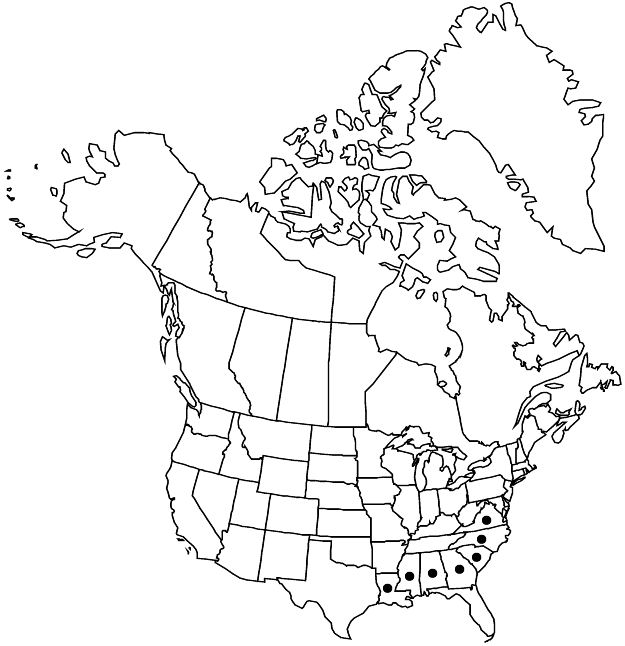Crataegus iracunda
Biltmore Bot. Stud. 1: 124. 1902.
Shrubs or trees, 30–80 dm. Stems: twigs: new growth greenish, glabrous, 1-year old deep reddish brown, 2-years old grayer; thorns on twigs 2-years old blackish or dark gray, shiny, slender, 2.5–4 cm. Leaves: petiole length 40–50% blade, eglandular; blade ovate to ovate-deltate, 2–4(–5) cm, 1.2–1.4 times as long as wide, 40–60% mature size at anthesis, base broadly rounded to subtruncate or subcordate, lobes 4 per side, sinuses moderately shallow, lobe apex ca. 90 at tip, often less, margins serrate, teeth regular, 0.5–1 mm, with minute, caducous gland-tipped, veins 3 or 4(or 5) per side, apex acute, abaxial surface glabrous except along veins, adaxial finely appressed-pubescent young. Inflorescences 4–10-flowered; branches glabrous; bracteoles few, ± linear. Flowers 12–15 mm diam.; hypanthium glabrous; sepals 4–5 mm, margins ± entire or slightly glandular-serrate, abaxially glabrous; stamens 10, anthers pink to purple; styles 3–5. Pomes orange to red, or blotched green, suborbicular, 8–10 mm diam.; sepals spreading; pyrenes 3–5, dorsally grooved.
Phenology: Flowering Apr; fruiting Sep–Oct.
Habitat: Open woodlands, brush, fencerows, cutovers
Elevation: 20–300 m
Distribution

Ala., Ga., La., Miss., N.C., S.C., Va.
Discussion
Crataegus iracunda ranges from Louisiana to South Carolina and Georgia, and to Virginia, but only at low altitudes. Nearly all records of C. iracunda north of the listed distribution are referable to C. macrosperma or to various species in ser. Populneae.
The distinguishing features of Crataegus iracunda are most evident when it is in flower. The species can be construed as a smaller, more southern, allopatric relative of C. macrosperma distinguished by smaller leaves (particularly at anthesis), more slender thorns, and harder, drier pomes. Its distribution is almost wholly to the south of or in Appalachia, at lower elevations than C. macrosperma. The nearest records of C. macrosperma to the Louisiana populations of C. iracunda are from the Arkansas Ozarks.
Crataegus iracunda has been confused with C. gattingeri (ser. Pruinosae) but is readily distinguished in flower by adaxial leaf pubescence, stamen number, and by lacking the usually attenuate terminal leaf lobes of the latter. However, in fruit, unless the filament bases can be counted, one is left with the less reliable feature of the terminal lobe shape. Confusion with the larger-leaved C. populnea (ser. Populneae) is perhaps possible, but the two species are essentially allopatric and their leaves differ markedly in size and texture.
Earlier attempts to segregate varieties based on leaf size are not taken up here but may have merit as the relatively numerous Louisiana (Crataegus drymophila) form has much smaller leaves than North Carolina specimens.
Variety brumalis (Ashe) Kruschke (Crataegus brumalis Ashe) with syntype material from near Pittsburgh, Pennsylvania, is a different entity. Compared to C. iracunda, it has larger and differently shaped (often more or less truncate-based) leaves, proportionately larger at anthesis, and adaxially subglabrous, conspicuously glandular petioles, and larger flowers. This taxon (as a variety of C. iracunda) is primarily responsible for the northwards extension of the range of the latter species. In fact, north of the Mason-Dixon line, most of the specimens attributed to C. brumalis seen by the author appear to be forms of C. macrosperma.
Selected References
None.